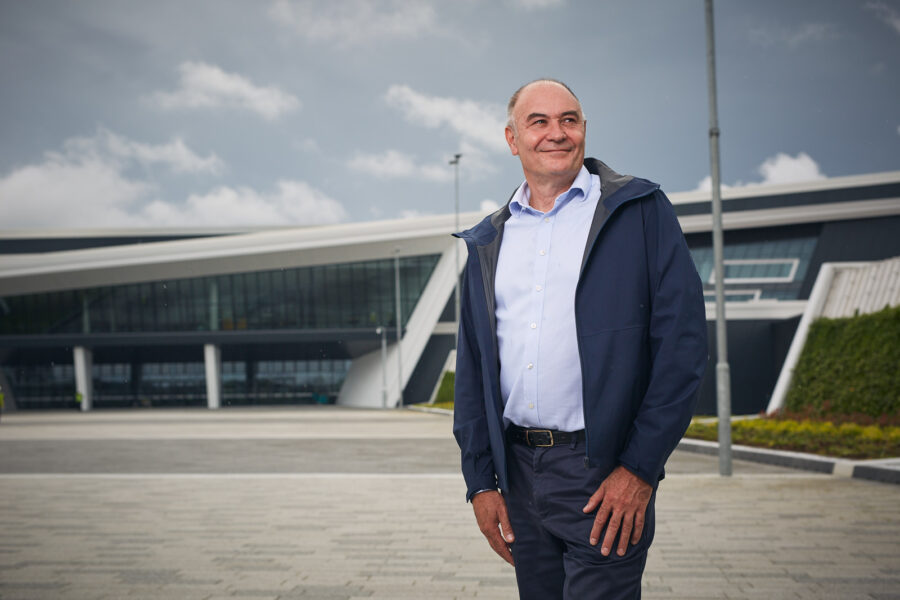HBD’s Project Director in Scotland, Nigel Munro, explores new hydrogen technologies and the role they’re playing in tackling climate change.

HBD completed the £330m TECA Arena and Conference Centre in the summer of 2019 and the venue hosted the world-renowned Offshore Europe exhibition in September that year. Little did we know the turn of events that would see it unable to operate just six months later.
Developing in Aberdeen and working closely with Aberdeen City Council was a rewarding experience and introduced us to the aspirations of the city and the oil and gas industry to forge a new future in renewable energy. The goal was to make TECA the most sustainable venue of its type in the UK, reinforcing Aberdeen’s status as Europe’s Energy Capital. The Council had a strong and ambitious vision to explore the use of hydrogen and we jointly developed an energy strategy for the scheme which had, at its heart, a green on-site energy centre containing the largest hydrogen fuel cell installation in the UK. This has a total electrical output of 1.4MW – enough to meet all the electrical demands of TECA.
An on-site Anaerobic Digestion (AD) Plant – which will use the city’s food waste, agricultural waste and purpose-grown crops – produces renewable biogas, which is upgraded to pure biomethane to feed the fuel cell. Any leftover biogas will be injected into the main gas grid.
The UK produces a staggering 10 million tonnes of food waste each year. Around 7.3 million tonnes of this are household food waste, costing families on average £470 per annum and causing significant damage to the environment. Most domestic, commercial, and industrial food waste still ends up in landfill where it rots, giving off methane, a powerful greenhouse gas. But by sending food waste to AD plants, it can be used to generate clean energy with a by-product of valuable biofertilizer for farmland, also significantly reducing greenhouse gas emissions.
Since TECA was created, the legislation to reduce carbon emissions has tightened, but increasingly the demand from occupiers and purchasers is more ambitious than the legislation and is often now the driver. For many, this demand has brought a fear of the unknown, but the widespread adoption of PVs and electrically powered air-source heat pumps has, it seems, rapidly become the ‘off-the- shelf‘ design solution.
With the equally rapid rise in demand for EV charging points, however, it is clear that the power network will be unable to serve that demand and the scale of the challenge suggests that an improved and strengthened network is some time off. So how can we bridge that gap?
With our experience at TECA in mind, one of the obvious answers is hydrogen. Power-to-gas technology (often abbreviated to P2G) can be utilised to convert green electrical power to produce hydrogen. The hydrogen can be stored and transported in the form of compressed gas, often using existing infrastructure for long-term transport and storage. The attraction of this is that the gas produced acts like a battery, storing energy where we have a surplus of clean renewables (wind, solar, tidal) for use whenever we need it. As the use of renewable energy continues to grow, there will be an ever-increasing need to support ramping and smoothing of renewables and to enable storage of the over-production. We are early in the evolution of P2G technology, but Audi has developed a capability in Germany, while Japan has a commercial-scale plant in operation.
Electric vehicle (EV) demand is rising exponentially, but power to gas could also play a role here, with hydrogen buses in use in Aberdeen, as well as Toyota and Hyundai producing cars in competition to EVs.
Banning gas boilers in buildings from 2025 is a bold step, but we need to find alternatives to a switch to electric. After all, central heating is responsible for up to a third of the UK’s greenhouse gas output. At Keele University, zero-carbon hydrogen has been injected into a UK gas network for the first time in a ground-breaking trial that could help to reduce carbon dioxide emissions. The 20% hydrogen and natural gas blend is being used to heat 100 homes and 30 faculty buildings. Unlike natural gas, when hydrogen is burned, it produces heat and water as opposed to carbon dioxide.
Closer to home, in Fife, the H100 project has seen 300 houses directly consuming hydrogen. The initial customers joining the project will receive a free hydrogen connection, free replacement appliances and free maintenance over the length of the project. They will pay the same amount for hydrogen gas as they would pay for natural gas. There are, of course, some challenges to using the natural gas network for transporting hydrogen, but these are being gradually resolved.
The drive for a greener future is increasing daily and fundamental to our efforts to protect the environment. The Government’s independent advisors, the Committee on Climate Change (CCC), have highlighted technology as key to making the UK’s net zero emissions target feasible and cost-effective. Increased funding and strong Government support are essential to bring new technology to the mainstream more quickly and avoid the devastating impacts of unmitigated climate change.
If you enjoyed this post, why not subscribe for updates below!